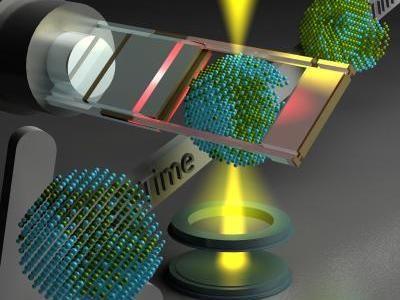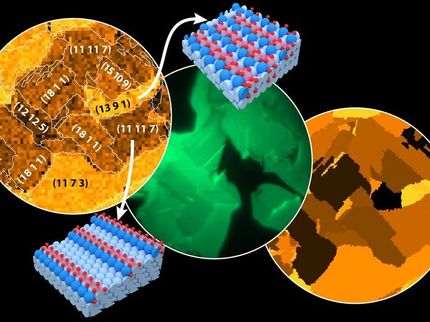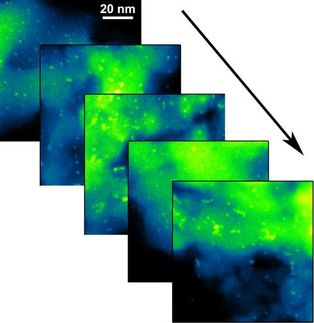Tracking of individual catalyst nanoparticles during heating
Researchers from McMaster University in Hamilton, Ont., have taken atomic-level images of individual nanoparticles during heating that could lead to improved fuel-cell technologies at lower cost, reduce dependence on imported oil and minimize greenhouse gas emissions.

McMaster researchers have taken atomic-level images of individual nanoparticles during heating that could lead to improved fuel-cell technologies at lower cost, reduce dependence on imported oil and minimize greenhouse gas emissions.
McMaster University
Heating nanoparticles and atomic-level tracking allows for the development of other less expensive catalysts, such as platinum-iron nanoparticles. Typically, pricey platinum nanoparticles are used. Using advanced electron microscopic techniques the team was able to track the atomic-rearrangement process of an individual Platinum-Iron nanoparticle - as it got annealed inside the microscope.
"Our work is pioneering in the application of advanced electron microscopy techniques to study the structural and compositional transformation of individual nanometer-sized particles during heating," said Gianluigi Botton, Professor of Materials Science and Engineering at McMaster University. The researchers' work on nanoparticles could have far-reaching impact on the automotive industry.
With the depletion of fossil fuel reserves, there has been a surge of interest in developing alternative energy sources, particularly in the area of fuel cell technology. Fuel cell devices can power vehicles by converting chemical energy into electrical energy in a far more efficient and environmentally-friendly way than the conventional combustion technologies. However, they rely on catalysts to operate and reducing catalyst-cost is crucial for commercialization.
McMaster's research team comprising of Sagar Prabhudev (Materials Science and Engineering PhD Student), Dr. Matthieu Bugnet (Post-doctoral researcher) and Botton carried out their work in collaboration with Dr. Christina Bock (NRC, Ottawa) and Dr. Guozhen Zhu (Shanghai Jiao Tong University, China).
"Imagine that you placed millions of nanoparticles on a pan and started heating," said Prabhudev. "During the course of heating, you select one of the particles. And, with the help of a powerful microscope, watch the atoms move. That is the equivalent to what we have done."
A Titan 80-300 cubed microscope at McMaster's Canadian Center for Electron Microscopy (CCEM) was used for the research. "In terms of capability, Titan electron microscope is similar to the Hubble Telescope. The difference is that the Titan allows us to explore atomic structure of materials, instead of stars and galaxies," said Botton, also the Scientific Director of CCEM. "This includes identifying atoms, measuring their chemical state and even probing the electrons that bind atoms together."
The researchers point out that the insights obtained were previously inaccessible with traditional analytical methods.
Original publication
Other news from the department science
These products might interest you

NANOPHOX CS by Sympatec
Particle size analysis in the nano range: Analyzing high concentrations with ease
Reliable results without time-consuming sample preparation

Eclipse by Wyatt Technology
FFF-MALS system for separation and characterization of macromolecules and nanoparticles
The latest and most innovative FFF system designed for highest usability, robustness and data quality

DynaPro Plate Reader III by Wyatt Technology
Screening of biopharmaceuticals and proteins with high-throughput dynamic light scattering (DLS)
Efficiently characterize your sample quality and stability from lead discovery to quality control

Get the chemical industry in your inbox
By submitting this form you agree that LUMITOS AG will send you the newsletter(s) selected above by email. Your data will not be passed on to third parties. Your data will be stored and processed in accordance with our data protection regulations. LUMITOS may contact you by email for the purpose of advertising or market and opinion surveys. You can revoke your consent at any time without giving reasons to LUMITOS AG, Ernst-Augustin-Str. 2, 12489 Berlin, Germany or by e-mail at revoke@lumitos.com with effect for the future. In addition, each email contains a link to unsubscribe from the corresponding newsletter.
Most read news
More news from our other portals
Last viewed contents
LANXESS appoints Mito Polimeri as partner
Bruker AXS Announces Agreement to Acquire the Princeton Gamma-Tech (PGT) X-Ray Microanalysis Business

Gantner Instruments GmbH - Schruns, Austria
Cognis Care Chemicals joins the Chemidex Cybrary: online access to technical product data




























































